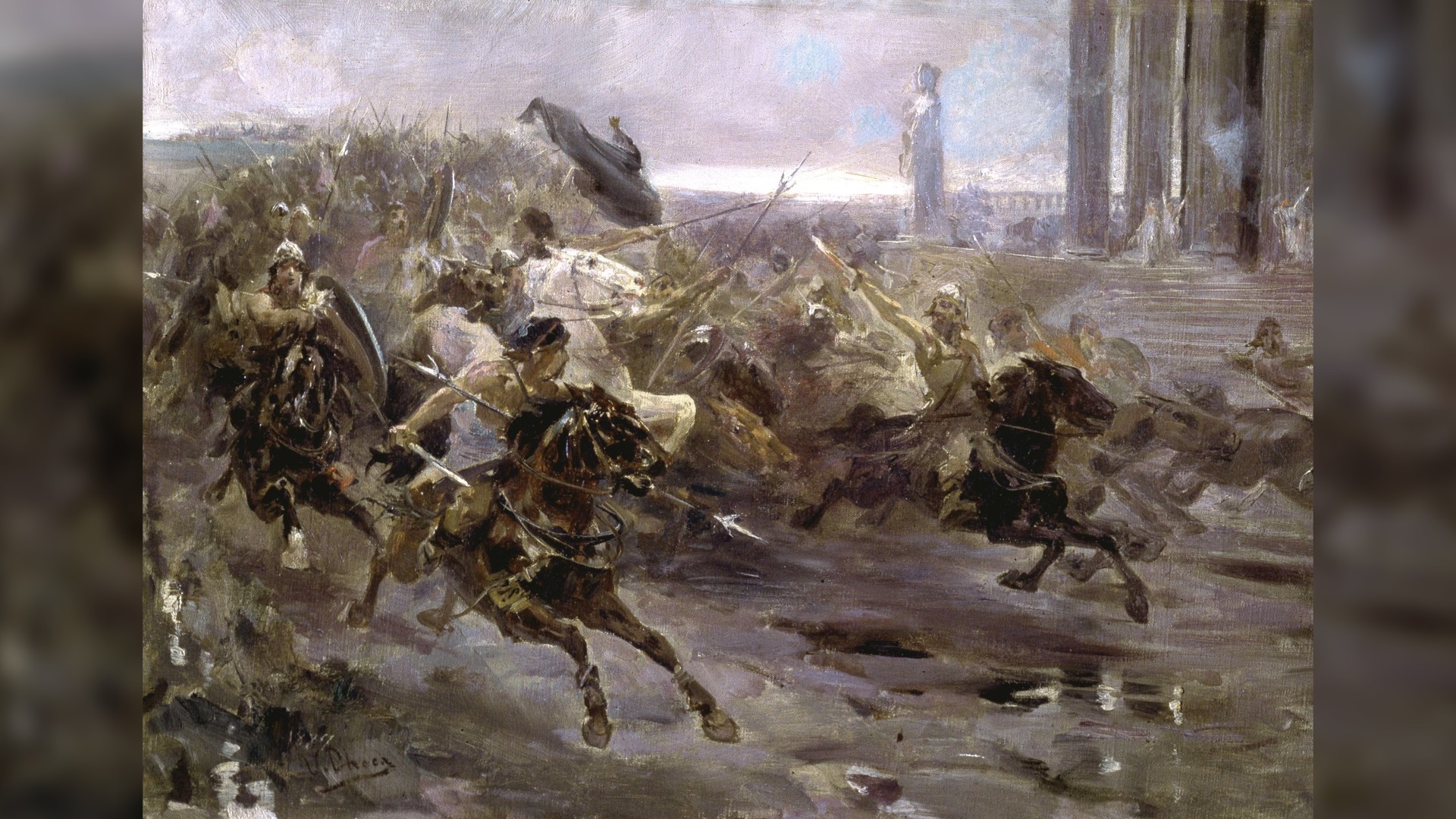Attila the Hun raided Rome due to starvation, not bloodlust, study suggests
The infamous barbarian's most devastating incursions took place in years with extremely dry summers.

Attila the Hun has been depicted as a bloodthirsty barbarian with an "infinite thirst for gold" and power. But a new study proposes an alternative explanation for his violent incursions: Attila may have carried out his desperate raids to save his people from drought and starvation.
Two thousand years of climate data, recorded in the rings of oak trees found around the floodplains of Central Europe's Danube and Tisza rivers, have shown that Attila and his Huns carried out their biggest raids during very dry years, when crop yields and pastureland were sparse, meaning the attacks were likely partly driven by desperation and hunger. The researchers published their findings Dec. 14 in the Journal of Roman Archaeology.
The Huns are thought to have crossed into Eastern and Central Europe from Asia around A.D. 370 before establishing themselves on the Great Hungarian Plain (a part of the wider Carpathian Basin), east of the Danube. Just 60 years later, through a combination of advanced weaponry, unrivaled horsemanship and sophisticated battle tactics, the Huns had subjugated much of Central Europe into a confederation of Eurasian tribes over which they reigned supreme. At its height, the Hunnic Empire stretched from the Black Sea to central Germany and, following Attila and his brother Bleda's rise to power in A.D. 434, found itself right at the doorstep of what had become a bifurcated Roman Empire, in whose downfall the Huns would play a major role.
Related: Where is Attila the Hun's tomb?
"Historical sources tell us that Roman and Hun diplomacy was extremely complex," study author Susanne Hakenbeck, an archaeologist at the University of Cambridge in the U.K., said in a statement. "Initially it involved mutually beneficial arrangements, resulting in Hun elites gaining access to vast amounts of gold [in exchange for not attacking the empire]. This system of collaboration broke down in the 440s, leading to regular raids of Roman lands and increasing demands for gold."
Living on the Eurasian Steppe between A.D. 420 and 450 would have exposed the Huns to a harsh and capricious climate, the archaeologists said, with multiple droughts forcing them to alternate between farming in fixed locations and herding their animals to greener pastures.
"If resource scarcity became too extreme, settled populations may have been forced to move, diversify their subsistence practices, and switch between farming and mobile animal herding," Hakenbeck said. "These could have been important insurance strategies during a climatic downturn."
Sign up for the Live Science daily newsletter now
Get the world’s most fascinating discoveries delivered straight to your inbox.
But this unstable caloric balancing act soon gave way to more desperate times and measures. In years of severe drought, when the Huns faced starvation, they transformed into merciless raiders, spilling out from the Carpathian Basin to loot and pillage across Western and Southern Europe. In fact, the most devastating Hun incursions took place in A.D. 447, 451 and 452, all of which had extremely dry summers.
And the raids, once thought to be driven primarily by a lust for gold and power, may have been mainly concerned with acquiring food, the researchers suggested. However, gold also would have come in handy to maintain Attila's patchwork of warlord allegiances.
"Climate-induced economic disruption may have required Attila and others of high rank to extract gold from the Roman provinces to keep war bands and maintain inter-elite loyalties," Hakenbeck said. "Former horse-riding animal herders appear to have become raiders."
Under Attila's command in A.D. 451, the Huns invaded the Western Roman province of Gaul (situated in modern-day France) and northern Italy, capturing the city of Milan and extracting an eye-watering sum from the besieged Western Roman Empire to relent their attacks. Attila also demanded a swathe of land "five days' journey wide" along the Danube, possibly to offer the raiders guaranteed grazing land during even the worst drought, the archaeologists said.
The Huns' reign did not last long. In A.D. 453, following a bout of heavy drinking on the night of his last wedding (Attila had multiple wives), the Hunnic leader was found dead, having choked to death on his own nosebleed. The Huns fell to infighting, and soon splintered before scattering into obscurity. Rome never fully recovered from the effects of the Hunnic raids, and the Western Roman Empire fell 23 years later — proof, according to the archaeologists, that climatic disruption can fatally weaken even the most accomplished human societies.
"Climate alters what environments can provide and this can lead people to make decisions that affect their economy, and their social and political organization," Hakenbeck said. "Such decisions are not straightforwardly rational, nor are their consequences necessarily successful in the long term.
"This example from history shows that people respond to climate stress in complex and unpredictable ways, and that short-term solutions can have negative consequences in the long term," she added.

Ben Turner is a U.K. based staff writer at Live Science. He covers physics and astronomy, among other topics like tech and climate change. He graduated from University College London with a degree in particle physics before training as a journalist. When he's not writing, Ben enjoys reading literature, playing the guitar and embarrassing himself with chess.









